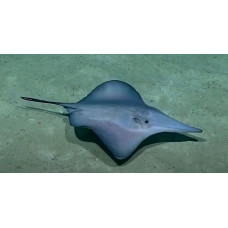Latin name
Hexatrygon bickelli
Other names
Hexatrygon bickelli
Identification
Body flabby, massive, snout elongated, triangular, flattened dorsoventrally, transparent, filled inside with gelatinous mass. In adults, the snout is much longer than in immature individuals, up to 2/5 of the total body length. In the air, the snout of dead individuals can shrink considerably. Tiny eyes are widely spaced and located on the top of the head. Far behind the eyes are large spatulas which are closed by external folded flaps. The nostrils are also widely spaced, with a pair of short, fleshy folds between them, which meet in the middle to form a leathery "curtain". The wide mouth is almost not curved, in the mouth are 44-102 small blunt teeth, forming a staggered "rub". Adults have more teeth. On the underside of the disk are six gill slits on each side. There are also six gill arches. The length of the rather thick tail is 0.5-0.7 of the length of the disc. There are one or two serrated spines on the dorsal surface of the tail at a distance from the base. The delicate skin is scaleless.
Features of fish fins
The pectoral fins form a rounded disk with length exceeding width, these proportions increasing with age. The pelvic fins are broad and rounded. At the end of the tail is a long, leaf-shaped caudal fin, the upper and lower lobes of which are nearly symmetrical.
Fish colouring
In living individuals, the dorsal surface is scarlet brown, becoming dark brown after death. The ventral side is white with dark edges on the disc and at the base of the pelvic fins. Underside of caudal peduncle dark. Dorsal rays (total): 0; Dorsal soft rays (total): 0.
Distribution
Inhabit the western Pacific Ocean from Japan and the South China Sea to Australia, and the Indian Ocean from the coast of South Africa to southwestern India, off the coasts of several Indonesian islands, and in western Australian waters.
Habitat
Deep-sea submersible species. Occurs on the slope of the mainland and near seamounts at depths of 350 to 1120 m.
Size
Males have a maximum length of 143 cm and females have a maximum length of 117 cm.
Behavior
The long snout is well curved both horizontally and vertically and is probably used by stingrays to search for prey on the bottom. The underside of the snout is covered with numerous Lorenzini ampullae, arranged in longitudinal rows, which are capable of picking up tiny electrical impulses emitted by other organisms.
Food and feeding habits
The mouths of these stingrays are able to extend far downward, beyond the head, allowing them to pull out buried prey. The jaws are weakly mineralized, so they do not prey on animals with hard shells or carapaces. Feeding habits are unknown.
Reproduction
Sixgill stingrays reproduce by live birth, with a litter of 2 to 5 newborns about 48 cm long. Males and females reach sexual maturity at 1.1 m in length.
Fishing
This species is of no interest to commercial fisheries. They are occasionally caught as by-catch in deep-sea fisheries in Taiwanese waters.
Relationship with a person
Sixgill stingrays are not dangerous to humans.
| Classification | |
| Phylum | Chordata |
| Class | Chondrichthyes |
| Squad | Myliobatiformes |
| Family | Hexatrygonidae |
| Genus | Hexatrygon |
| Species | H. bickelli |
| Features | |
| Conservation status | Least Concern |
| Habitat | Pelagic |
| Life span, years | No information |
| Maximum body weight, kg | No information |
| Maximum length, cm | 143 |
| Sailing speed, m/s | No information |
| Threat to people | Edible |
| Way of eating | Predator |
Sixgill stingray
Tags: sixgill stingray



